The Power to Save Padmé
In the lead-up to the The Phantom Menace’s return to theaters, StarWars.com devoted an Episode I-themed week to Queen Amidala, and Lex and I decided there was no better time to wrap up our discussion of Padmé. Since we both took a turn at delving into her character – Tricia with What is Strong? and Lex with The Life and Death of Padmé – it seemed appropriate for us to finish with a combined final look at her portrayal. We admire Lucas for his storytelling and the monumental steps he made with Princess Leia and Padmé on behalf of strong female characters, but we still feel a couple of storytelling points have kept those two characters off the all-time strong female heroines lists, and we thought it was worth discussing the reasons why.
Tricia: No doubt The Phantom Menace is the strongest portrayal of Padmé within the Prequel Trilogy. She stands firm in the face of oppression, doesn’t wilt before the Senate, and returns home to fearlessly defend her people when a diplomatic solution becomes untenable. 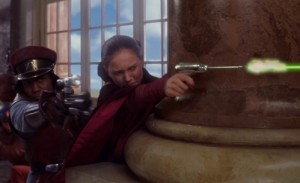 In Attack of the Clones, this same ferocity and passion for the Naboo is on display, but in the move to reveal her sexual awakening that paralleled Leia’s in The Empire Strikes Back, Lucas managed to cheapen her character instead of enhance it. I remember the first time I watched the arena sequence. When Padmé steps off the chariot that has taken her into an arena of blood-thirsty bugs, she’s not a love-swooning woman after finally declaring her love to Anakin; instead, she proceeds to save herself from bondage to the huge phallic symbol while her male Jedi counterparts bickered, still trapped in their chains. I absolutely loved the scene – right up until the moment the nexu strips off half her shirt to reveal Padmé’s midriff. It’s ironic that her kick-butt moment is exactly the point that Padmé began losing traction as a strong female character.
In Attack of the Clones, this same ferocity and passion for the Naboo is on display, but in the move to reveal her sexual awakening that paralleled Leia’s in The Empire Strikes Back, Lucas managed to cheapen her character instead of enhance it. I remember the first time I watched the arena sequence. When Padmé steps off the chariot that has taken her into an arena of blood-thirsty bugs, she’s not a love-swooning woman after finally declaring her love to Anakin; instead, she proceeds to save herself from bondage to the huge phallic symbol while her male Jedi counterparts bickered, still trapped in their chains. I absolutely loved the scene – right up until the moment the nexu strips off half her shirt to reveal Padmé’s midriff. It’s ironic that her kick-butt moment is exactly the point that Padmé began losing traction as a strong female character.
Lex: While The Clone Wars continues to further build up her strong side, the television series is limited in its ability to repair the damage done by these elements in the movies. Although Palpatine lures Anakin with the offer of the power to save Padmé from death, only one man truly holds the power to save her characterization.
For all the heat he has taken in some quarters for making small revisions to new releases of his own films, George Lucas never apologizes for tinkering with the movies. In fact, he frequently insists that he only makes these edits to bring the films closer in line with the vision in his head. 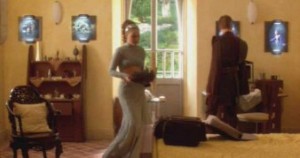 Some edits are basically superficial, like the additional and enhanced visual effects for Cloud City in The Empire Strikes Back or the blinking Ewoks in Return of the Jedi. Some add content without affecting the story, such as the quick appearance by Jabba and Boba in A New Hope or the extended Podrace opening in The Phantom Menace. Others, though, do change the characterization implications, including swapping in Hayden Christensen as the redeemed Anakin’s Force Ghost and, most notoriously, Han Solo no longer definitively shooting first. Most dramatically of all, perhaps, Lucas not only filmed new footage of Ian McDiarmid for the brief conversation between Vader and the Emperor in Episode V, but also rewrote the dialogue to more directly connect the two trilogies.
Some edits are basically superficial, like the additional and enhanced visual effects for Cloud City in The Empire Strikes Back or the blinking Ewoks in Return of the Jedi. Some add content without affecting the story, such as the quick appearance by Jabba and Boba in A New Hope or the extended Podrace opening in The Phantom Menace. Others, though, do change the characterization implications, including swapping in Hayden Christensen as the redeemed Anakin’s Force Ghost and, most notoriously, Han Solo no longer definitively shooting first. Most dramatically of all, perhaps, Lucas not only filmed new footage of Ian McDiarmid for the brief conversation between Vader and the Emperor in Episode V, but also rewrote the dialogue to more directly connect the two trilogies.
From this perspective, then, it’s fair to ask: why not make a few edits on Padmé’s behalf, too?
The easiest edits would also pay big dividends for her portrayal: restoring the deleted Naberrie family scenes from Attack of the Clones and the deleted political dissent scenes from Revenge of the Sith.  The scenes in her childhood home, discussing her upbringing and interacting with her family, add a great deal of dimension to Padmé’s character, as well as showing a more positive and endearing side of Anakin that helps convey what she found so easy to love about him. Likewise, the scene with Padmé and her allies in the Senate form a direct connection to her daughter’s Rebellion two decades later. They also form a juxtaposition of strength – even standing up to the Chancellor, to his face, just days before giving birth – against the more anxious and tearful scenes. If the movies can bear the weight of the additional time for scenes such as Jabba in Episode IV or the extended Podrace in Episode I, surely they also can afford a few extra minutes to bolster and support Padmé’s characterization.
The scenes in her childhood home, discussing her upbringing and interacting with her family, add a great deal of dimension to Padmé’s character, as well as showing a more positive and endearing side of Anakin that helps convey what she found so easy to love about him. Likewise, the scene with Padmé and her allies in the Senate form a direct connection to her daughter’s Rebellion two decades later. They also form a juxtaposition of strength – even standing up to the Chancellor, to his face, just days before giving birth – against the more anxious and tearful scenes. If the movies can bear the weight of the additional time for scenes such as Jabba in Episode IV or the extended Podrace in Episode I, surely they also can afford a few extra minutes to bolster and support Padmé’s characterization.
Tricia: Unfortunately the midriff-baring in the arena scene cannot be as easily remediated. For all its titillating nature, the infamous metal bikini actually served the story in Return of the Jedi; it emphasized both Jabba’s despicable personality and Leia’s strength and courage to literally turn the chains of her degradation back upon her tormentor. Padmé’s light blue dress with a bare midriff on Tatooine both fits the context of the searing desert and displays an informality and openness toward Anakin in the moments before he heads off to seek his abducted mother. Sadly, nothing similar can be said about Padmé’s arena experience. Having the nexu rip off the bottom half of the shirt to her diplomatic attire is simply gratuitous – it adds nothing to the story or to her characterization. Instead, it falls right into the typical pattern of marginalizing female characters by showing their skin. As much as Lucas wants Padmé to be a strong character, this aspect of Episode II will mark a contrary indication.
Lex: On the other hand, it may not be too late to repair some of the harm from the single most damaging scene of all – Padmé’s death in the medical ward on Polis Massa.
Medical Droid: Medically, she is completely healthy. For reasons we can’t explain, we are losing her.
Obi-Wan: She’s dying?
Medical Droid: We don’t know why. She has lost the will to live. We need to operate quickly if we are to save the babies.
Simply deleting a single sentence – “She has lost the will to live.” – would change the nature of this exchange from an objective medical analysis to an inexplicable mystical phenomenon. 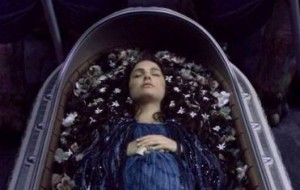 Rather than a presumably reliable assessment from a droid, seeming to place the blame on Padmé’s own lack of fortitude, her fate would be mysterious and beyond her control. No one blames Qui-Gon or Shmi for the cruel twists of misfortune that took their lives. At a minimum, Padmé deserves the same.
Rather than a presumably reliable assessment from a droid, seeming to place the blame on Padmé’s own lack of fortitude, her fate would be mysterious and beyond her control. No one blames Qui-Gon or Shmi for the cruel twists of misfortune that took their lives. At a minimum, Padmé deserves the same.
In light of all the lore and backstory recently revealed in Darth Plagueis, however, it seems likely that George Lucas does in fact have in mind a more specific explanation for the causes of Padmé’s death. Thematically, for example, the symbolic connection of Anakin and Padmé as symbionts links their multiple rescues of each other in Episode I and their “true love” whirlwind romance in Episode II, and there is powerful resonance in the symbolism that Anakin and Padmé die as Vader and the twins are born. A single line of dialogue, perhaps from Yoda, could convey this metaphysical symbiotic notion quickly yet effectively.
Tricia: Or perhaps something else was going on. Was Anakin somehow subconsciously projecting his power through the Force to keep her alive, only to fail amid the pain of his reconstruction?
Lex: Was the medical droid simply incorrect in his diagnosis and Padmé actually was dying of her injuries, and only through her own strength of will held on long enough to save her children? (Although that possibility would strengthen Padmé, it also would make Anakin far more directly culpable in causing her death, something that Lucas seemed to deliberately avoid.)
Tricia: Or did Darth Sidious reach out through the Force to snuff out her light, believing he had killed not just Anakin’s wife but his child as well?
Lex: Whatever the explanation Lucas really intends to be the truth, he should reveal it – formally and officially as part of the Star Wars canon. 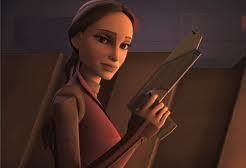 Ideally, by editing the dialogue in Revenge of the Sith itself for the expected 3D theatrical run and subsequent home-video releases. If not that, then at least in an Expanded Universe story, such as a Padmé lore book.
Ideally, by editing the dialogue in Revenge of the Sith itself for the expected 3D theatrical run and subsequent home-video releases. If not that, then at least in an Expanded Universe story, such as a Padmé lore book.
Until then, Padmé’s death scene will inevitably continue – rightfully – to undermine her strength in the mind of many Star Wars fans. I think it’s entirely fair for io9 to include Padmé on their list of the 10 Most Undignified Deaths in Science Fiction and Fantasy. Even with all the bravery and willpower that Lucas, Dave Filoni, and Cat Taber have brought to her character in The Clone Wars, nothing in those pre-Episode III stories can erase the manner of her demise. Only George Lucas has the power to save Padmé from his own writing in Revenge of the Sith.
Tricia: Fans, of course, are not limited in the scope of their imaginations the way George Lucas presumably would feel constrained to make only minor edits to the film. Back in the heyday of Prequel Trilogy fanfiction, both before and after the release of Episode III, fans conceived numerous heroic deaths for Padmé that gave her an exit far more worthy of her status as a strong female heroine and one of the saga’s Big Six protagonists. Not to mention a wide range of alternate-universe tales in which Padmé survived Episode III, an option presumably not available in the canon.
Lex: Or is it?
Tricia: This fangirl thinks resurrecting Darth Maul is a nifty turn of events, but I’m not sure anyone’s ready for Padmé to emerge from the hereafter. I’m actually fine with the tragedy of her death, just not how her heroic nature was diminished by a couple of poor storytelling choices. The fact is, there were some potentially better ways to end Padmé’s life.
Lex: Agreed. There are simple modifications like a mystical explanation for her death in childbirth or building upon the concept art with Padmé bringing a knife to Mustafar to face Anakin, to significant differences like a combat showdown with Vader or the Emperor after the children are born and already in hiding.
Tricia: Similarly, it’s worth considering why Padmé’s death scene has affected so many people’s perceptions of her character so substantially. Certainly it could have been worse, whether a Romeo-and-Juliet Shakespearean suicide or a melodramatic “I can’t live without him” overt declaration of hopelessness. Why does one weak moment, disappointing as it is, undermine everything else about Padmé’s strengths to such a degree? Is there a double standard at play – would a male character with an equivalent weak moment be judged so harshly? Perhaps he would, but I wonder.
Lex: Regardless, the issues raised by her death in Revenge of the Sith present a great case study for thinking about strong female heroines, their character arcs, and their fates. Although it is probably too late to save Padmé’s story, learning from her tale presents the opportunity to do better with other characters in the future.
Feel free to share in the comments your thoughts on the various versions of Padmé’s death, and why her death scene in Episode III troubles fans so much.
- Hyperspace Theories: The Curious Case of Kathleen Kennedy’s Retirement - March 10, 2025
- Hyperspace Theories: SKELETON CREW Ahoy! - December 29, 2024
- Hyperspace Theories: WICKED Part I Rises to the Moment - December 6, 2024

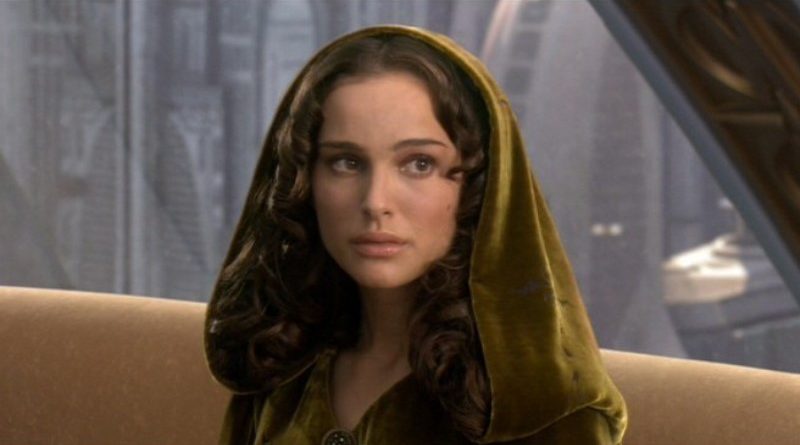










What’s WRONG with Padme losing the will to live?
What happened to her on that day would have sent many a normal person into a deep (clinical) depression, the kind where you – yes – lose the will to live. And it’s consistent with her characterization in all three prequel films and The Clone Wars. We never see her living for herself, only for others. She dedicates her whole life to serving her people and the Republic. We see her risking her life, without hesitation and without fear, for what she believes in. She lives for what she loves – ideals (liberty, democracy) and people (Anakin). It makes sense that when everything she lived for is no more, she dies.
The only problem with how she dies is lack of biological realism. Her losing the will to live is plausible. But losing the will to live doesn’t kill immediately. The person stops eating, moving, etc. and wants to die but doesn’t even have the energy to attempt suicide. It should have taken her much longer to die – the time it takes for the body to waste away. It looks like George Lucas tried to make a compromise between having Padme commit suicide and her dying through losing the will to live, when he should have decided on one OR the other.
There’s one huge problem with the “she has nothing left to live for” argument: the baby(s). She and Anakin were happy about the pregnancy, she was prepared for her political career to end and she was planning on settling down to raise the child/children. Even with Anakin gone there was a reason to keep going. As a mother and an army wife who has had contact with other wives who have given birth after losing their husbands in combat I can tell you right now the idea of Padme giving up with her beloved husband’s child in the equation is nonsense.
I read a fanfiction once where Padme knew Anakin had survived and discovered they were indeed connected. She realized Anakin would be able to track her and thru her, the twins. So she deliberately ‘lost the will to live’ in order to protect the children. That was semi-palpable like some of the ideas you guys threw out.
You guys are right though, that one sentence needs to go. Eliminating it wouldn’t fix everything but it would resolve the most glaring issue.
So your argument is “I and the other women I know wouldn’t have done this, so Padmé couldn’t have”? Sounds like a most common bias among viewers of fiction: we relate to a character and fail to see how different from us that character is. It’s a mistake to assume Padmé thinks like normal people we know, because she really isn’t that kind of character. She’s quite peculiar and dysfunctional. I have a whole post in my blog about this, if anyone is curious.
No, the argument is that Padmé is a strong and heroic character – and a character like that should not be written with a death contingent on her own emotional weakness. That is why the way Padmé’s death is written does such damage to her character – it undermines her strength as a character, and causes some fans even to retroactively doubt the otherwise strong portrayal of her previously. If her death had been written one of the other ways we suggested, her death would not be attributable to her own weakness – and that would be more consistent with the rest of her characterization.
Star Wars is epic myth, and the Prequels are tragic epic myth. You’ve actually got it backwards: We’re not judging her relative to real-world women and how they might react to this kind of emotional trauma, but rather comparing her to the kind of heroic archetypes that Star Wars is modeled on. The comparison should be, for example, to her daughter Leia, who stands tall and leads her own rescue from the Death Star shortly after watching her homeworld obliterated in front of her. To write Padmé so weak by comparison does a great disservice to her character, especially compared to the Padmé of TPM, AOTC, and TCW. So – in my opinion – to looking at Padmé’s reaction in terms of real-world concepts like clinical depression, PTSD, or biological realism is missing the point.
My comment was a reply to Joanne’s comment, not to the original post.
There are plenty of tragic/mythological heroines who “die of a broken heart”, as lazypadawan points out in this essay. Seems you’re the one who got something backwards.
Actually that’s not my position – that “I wouldn’t have done this” therefore Padme shouldn’t have – because I’m not a mythic heroine.
Thanks for sharing your opinion. It’s exactly the type of dialogue we were hoping for. Perhaps for some people Padme’s death works as a storytelling choice and a clinical depression explanation is viable. All perspectives are valued and welcome.
It felt as if Lucas was trying to link Padme and Anakin’s fates with her death and him dying in a symbolic way, but missed the mark. I have to wonder if that one line had been removed if it would have appeared clearer.
Great wrap-up of your look at Padme. Really enjoyed the series.
Pingback:Defending Padmé Yet Again «
Lex and I have known lazypadawan since our early fanfic days and have always respected her passion for Anakin, Padmé, and the Prequel Trilogy. We appreciate the links to her website, and weren’t surprised to find that her perspective and ours are actually pretty close on many areas of Padmé’s story. Our difference of opinion on some things, though, is part of the fun of being a Star Wars fan. Whether it’s the PT, OT, TCW, or EU, Star Wars never has a shortage of issues to discuss and debate – and disagree, or agree to disagree, about. I think lazypadawan would prefer, as I do, that everyone do so with some courtesy.
To clarify some misconceptions that seem to have arisen in comments here and elsewhere: Lex and I are both big fans of all the Star Wars movies. We are also big fans of Padmé and her strength of character – which is why, seven years later, we still find the way George Lucas wrote the dialogue explanation of her death so disappointing. There is room for improvement in any work, including the Star Wars movies, and we don’t flinch from scrutinizing those points in George Lucas’ writing any more than we do in our own.
***
Because the reminder seems to be needed, we have a few simple rules to follow for comment approval:
1) Spelling and punctuation should be reasonably accurate.
2) No profanity.
3) Have actually read the post you’re commenting to. In other words, don’t try to tell the blogger she or he is wrong by using the points made in the post.
Thank you, Mr. McKenzie, for at least signing your name.
Pingback:The Life and Death of Padmé – Without Lore, Is It Just Lipservice for the Leading Lady of Star Wars? « fangirlblog.com